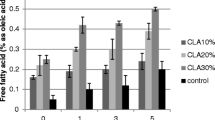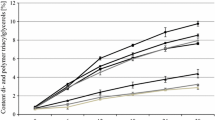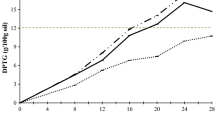Abstract
The objectives of this study were to determine a suitable level of phytostanols for addition to canola oil and to investigate the performance of the supplemented oil during frying. The frying oil was supplemented with 5, 10, 15, 20 % w/w phytostanols and two suitable levels (5 and 10 %) were selected. Dough frying was performed for 5 consecutive days at 180 °C for 5 h/day. The ranges of analytical measurements in the treatment groups were; free acidity (0.12–10.07 %), conjugated dienes (0.47–1.37 %), total polar material with probe (9.00–51.25 %), viscosity (46.27–195.51 cP), turbidity (0.82–1.80 NTU), and smoke point (202.75–274.25 °C). The results indicated that 5 % phytostanol enriched oil was superior in terms of oil stability and sensory quality of the fried dough among all the enriched oils. Samples with 10 % added phytostanols were high in free acidity, conjugated dienes and smoke points. Sterol composition analysis showed that the fried dough absorbed total sterols of 49.9 and 95 g/kg in 5 and 10 % supplemented oils, respectively. Hence, some health benefits could be achieved through consuming products which have been fried in phytostanol supplemented canola oil.

Similar content being viewed by others
References
Nguyen TT (1999) The cholesterol-lowering action of plant stanol esters. J Nutr 129:2109–2112
Harrabi S, St-Amand A, Sakouhi F, Sebei K, Kallel H, Mayer PM, Boukhchina S (2008) Phytostanols and phytosterols distributions in corn kernel. Food Chem 111:115–120
Schwartz H, Ollilainen V, Piironen V, Lampi AM (2008) Tocopherol, tocotrienol and plant sterol contents of vegetable oils and industrial fats. J Food Comp Anal 21:152–161
Oehrl LL, Hansen AP, Rohrer CA, Fenner GP, Boyd LC (2001) Oxidation of phytosterols in a test food system. J Am Oil Chem Soc 78(11):1073–1078
Boskou D (1998) Frying temperatures and minor constituents of oils and fats. Grasas Aceites 49(3–4):326–330
Lampi AM, Juntunen L, Toivo J, Piironen V (2002) Determination of thermo oxidation products of plant sterols. J Chromatogr B 777:83–92
Soupas L, Huikko L, Lampi AM, Piironen V (2007) Pan-frying may induce phytosterol oxidation. Food Chem 101:286–297
Winkler JK, Warner K, Glynn MT (2007) Effect of deep-fat frying on phytosterol content in oils with differing fatty acid composition. J Am Oil Chem Soc 84:1023–1030
Choe E, Min DB (2007) Chemistry of deep-fat frying oils. J Food Sci 72(5):77–84
Sims RJ, Fioriti JA, Kanuk MJ (1972) Sterol additives as polymerization inhibitors for frying oils. J Am Oil Chem Soc 49:298–301
Gertz C, Klostermann S, Kochhar SP (2000) Testing and comparing oxidative stability of vegetable oils and fats at frying temperature. Eur J Lipid Sci Technol 102:543–551
Meilgard M, Civille GV, Carr BT (1999) Sensory evaluation techniques, 3rd edn. CRC Press, Boca Raton
AOCS Methods (1998) Cc 9a-48, Ca 5a-40, Ti 1a-64, Cd 20-91 Official methods and recommended practices of the AOCS, 5th edn
AOAC (2002) Official Method 920.39. Association of official analytical chemists, 17 edn., vol 1, Arlington
ISO 12228:1999 (1999) Animal and vegetable fats and oils—determination of individual and total sterols contents—gas chromatographic method. ISO, Geneva
Minitab (2000) Minitab Statistical Software. Release 13.1, State College, PA
Aladedunye F, Przybylski R (2011) Rapid assessment of frying performance using small size samples of oils/fats. J Am Oil Chem Soc 88:1867–1873
TFC (2007) Official notification of the control criteria of frying fats/oils. Turkish Food Codex no: 2007/41. TFC, Ankara
Winkler JK, Warner K (2008) The effect of phytosterol concentration on oxidative stability and thermal polymerization of heated oils. Eur J Lipid Sci Technol 110:455–464
Paul S, Mittal GS (1996) Dynamics of fat/oil degradation during frying based on optical properties. J Food Eng 30(3–4):389–403
Ostlund RE (2002) Phytosterols in human nutrition. Annu Rev Nutr 22:533–549
Rudzinska M, Przybylski R, Wasowicz E (2009) Products formed during thermo-oxidative degradation of phytosterols. J Am Oil Chem Soc 86:651–662
Acknowledgments
This study was partially supported by the Çanakkale Onsekiz Mart University Research Fund No 2010/103. The authors would also like to thank Ak Gida Dairy Products and Beverage Company (Adapazarı, Turkey) for the phytostanol esters they donated.
Author information
Authors and Affiliations
Corresponding author
About this article
Cite this article
Aydeniz, B., Yılmaz, E. Phytostanol Supplementation Through Frying Dough in Enriched Canola Oil. J Am Oil Chem Soc 90, 687–694 (2013). https://doi.org/10.1007/s11746-012-2201-0
Received:
Revised:
Accepted:
Published:
Issue Date:
DOI: https://doi.org/10.1007/s11746-012-2201-0




